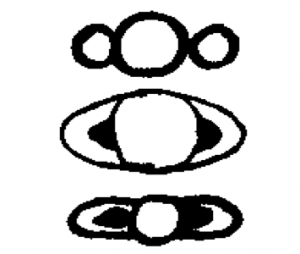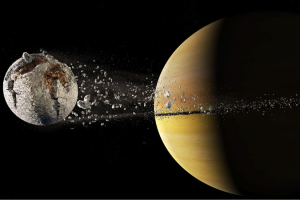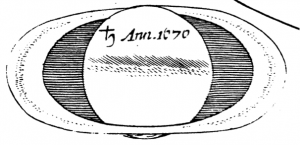Saturn’s Rings
By Skylar Ursu, Sydney Redekop, Maren Borys, Nadia Emilie Skoglund, and Valentin Alves da Motta da Cruz
Introduction
The fascination of the beauty of Saturn’s rings has lead astronomers to conquer many obstacles to discover the composition, as well as the mystery behind the visibility of Saturn’s rings. Research began because of human curiosity about this wonderful phenomenon and continued because of our realization that by understanding the rings, we might be able to understand how the solar system formed, and furthermore, could potentially predict how it will evolve. To fully understand the rings, we need to know and why Saturn has these rings. Through observation only, one might assume that the rings are a solid mass surrounding the planet, but by using scientific resources, astronomers can discern that they are, in fact, made up of particles consisting of a variety of materials. To this day, scientists are still learning and questioning about how the rings came to be, but they do have several theories that provide insight as to how they could have come about. With a wide assortment of instruments, ranging from basic telescopes and satellites to the tools aboard the Cassini Spacecraft, scientists have been able to measure magnetic fields, electric charges and densities of particles to achieve first hand results and knowledge of what has occurred around the Saturn. All the tools, missions, and data collected have helped in resolving the composition of the rings. By analyzing historical advancements, various formation theories, research data, and NASA’s Cassini mission, scientists, astronomers and students of all kinds aim to continue the exploration of Saturn’s ring composition.
History of the Rings & Telescope Advancements

Figure 1: Sketches of three drawing Galileo made of Saturn through the Galileoscope. “New worlds”, Couper & Henbest, p.86
Saturn has been observed and acknowledged since ancient times, but it was not until Galileo Galilei, an Italian astronomer, looked through his 20-powered telescope in 1610 and observed that there was handle, or arm-like objects around the planet.1 Since the telescope he was using was one of the first to be made, it was not very powerful and so he could not tell exactly what he was looking at. Christiaan Huygens later looked at the rings through a more powerful telescope, one that magnifies objects up to one hundred times and had a greater field of view than that of the telescope Galileo used2, and with this he proposed that the previously thought handles were a thin, flat ring that wasn’t attached to the planet. Later, with yet another more advanced telescope, Giuseppe Campani recognized that there was the difference in the intensity of some of the rings, but failed to realize that the rings were not all attached.3
Giovanni Cassini was the first to notice a space between large portions of the rings, and discovered that he was looking at two different rings. The gap between them was thenceforth known as the Cassini division and the rings were then to be named using a conventional, alphabetical system, A-ring, B-ring, etc.3
After this discovery, Saturn’s rings were further researched and studied by James Clerk Maxwell, a Scottish physicist. He made a prediction that the rings of Saturn were made up of an “infinite” number of “independently orbiting particles… [which] would have to be arranged in a series of narrow rings”.4 Maxwell spent two years researching about Saturn’s rings composition. He wrote “On the Stability of Saturn’s Rings” in 1859, where he concluded that the rings comprised a myriad of small solid particles.5 He also made this prediction when he figured that if the rings were not in particles, there would not be a gap between the planet and the rings, and would therefore crash into the planet due to its gravitational pull.4 This was then further confirmed as true by images sent back from Voyager Two. Voyager One and Voyager Two were crafts that were sent to Saturn to observe the planet, the rings, and the moons by flying by it and taking photos using spectroscopy. Spectroscopy pertains to the spread of an object’s light into its component colors (i.e. energies). By using this process, spreading and analysis of an object’s light, astronomers can derive the physical properties of that object.6 These properties can be temperature, mass, luminosity and composition. Following these two, the Cassini spacecraft was again another more advanced piece of technology used in the study of Saturn and was the first to orbit the planet. The Cassini mission has been the most productive observation of Saturn and will be explained in further depth later in this work.
As humans gained more technological knowledge, they created larger and more advanced telescopes, therefore introducing better angular resolution to see and study the rings of Saturn. However, these telescopes could only take research so far. To truly know and understand the rings, researchers needed to send various probes into the solar system to view Saturn and to study its rings up close.
Why does Saturn have rings?
Scientists are not 100 percent certain on the development of Saturn’s rings. Dr. Carolyn Porco, leader of Cassini Imaging Science Team, stated that it is unsure how the rings formed and how long they will persist. There are, however, three different theories as to how they formed. Each theory accounts for certain aspects of the composition of the rings, but they do not explain all the important details and none of the theories can be fully verified as truth.

“Titan-sized moon passing too close to Saturn sheds its out layer to form the planet’s majestic ring.” Photoshop and Lightwave 3D Steven Hobbs Copyright 2010
The first theory is that when Saturn was forming there could have been leftover debris and material floating around the solar system. It is speculated that because Saturn is so large and has such a great gravitational pull, collecting debris is significantly easy for this planet. This may be evident with the fact that scientists see 62 moons associated with Saturn. Hence, the materials floating around may have flown into the planet’s orbit, resulting in rings.7 This theory, however does not account for why the rings are so icy, as you will read later.
The second theory is the thought that a nearby moon was destroyed due to a large impact, possibly by an asteroid or a comet. The theory states that this would have produced chunks of debris that could have come together and formed the rings around the planet. In this case, the comet would have needed to be of great size (several hundred kilometres wide) for it to have the impact needed to result in Saturn’s ring formation. These comets would have needed to be a regular occurrence, passing by Saturn frequently with the potential for Saturn to disrupt its path.8
Lastly, the third and most recent theory is that a bygone moon may have been destroyed from the tidal forces from the planet Saturn itself, creating the rings. This theory explains the icy composition of the rings, but does not account for everything that is in orbit such as small moons on the rings’ outskirts. It was suggested by Dr. Robin Canup, from the Southwest Research Institute in Boulder Colorado, that the rings began from an old moon that formed too close to Saturn and was unable to keep a stable orbit. She created a computer model showing that as the moon ascended toward the planet the gravity from Saturn tore away its icy outer layer, resulting in the icy particle filled rings.9 As time went on the moon eventually broke down completely and all its rocky core material became incorporated into the rings.6
As of present time there is still no proven explanation for Saturn’s rings in the scientific community. The third theory mentioned above seems to be the most widely accepted, since the corresponding results of the rings composition coincides with the particles and process behind this theory.
The Composition of the Rings

Figure 4: Magnification of the Particles and Debris that Compose Saturn’s Rings J. Coffey, universetoday.com (2015). Copyright 2016 UNIVERS TODAY
The rings of Saturn are easy to spot from Earth if looking through any telescope, this is because the rings consist of 90-95 % ice.6 Ice has an albedo of 80-95 %, which means that the ice reflects that much Sunlight in a percentage of the light that reaches it.10 The pieces of ice collide with each other and are constantly changing shape.11 The remaining 5-10 % of the rings are made of sand and rocks, where the pieces of rocks range from being as small as a grain of sand to being as big a mountain.12 This is true for the pieces of ice as well as for the pieces of rock.11
Dr. Robin Canup made a computer model showing her theory (as mentioned previously) and it explains the icy nature of the rings, as well as explains the rocky material thought to be within them. She mentions that she believes that the rock and dust comes from the meteorites that have “peppered” the rings for billions of years.6

Figure 5: Saturn’s Rings with Names. By F. Cain, universetoday.com (2016). Copyright 2016 UNIVERS TODAY
Looking at the rings far away they look like many tiny strings, but they are quite wide and not very thick. Across, they are 273,600 km, but only 10 meters thick,12 and each of the rings orbits in a different speed around the planet. There are also quite big gaps between some of the rings. The largest gap is between ring A and B.13 The rings are named after the letters in the alphabet, going from A to G.13 The names of the rings are shown in Figure 5, where you can see that they are not labelled in alphabetical order, rather, their order is D, C, B, A, F, G, E.13 The reason for this is because the rings were not discovered all at the same time, the smaller rings were discovered more recently. Due to technology advancements allowing researchers and astronomers to see Saturn more clearly, rings were subsequently given a corresponding letter as they were discovered and recorded.
Though Saturn has the largest and most visible rings, it is not the only planet in our Solar System which has rings. Jupiter, Neptune and Uranus all have smaller ring systems surrounding their bodies.
Cassini Spacecraft and its Instruments
The Cassini Spacecraft has been a part of NASA’s most progressive mission in the observation of Saturn, its rings, and its moons. Before Cassini, scientists have never been able to study the ring’s size, composition, distribution, or temperature accurately. This revolutionary probe examined the chemical makeup of the material in the rings in detail using 12 different instruments, which are “designed to carry out sophisticated scientific studies of Saturn, from collecting data in multiple regions of the electromagnetic spectrum, to studying dust particles, to characterizing Saturn’s plasma environment and magnetosphere”.14 These instruments are grouped into three categories based on what components they are made for studying and analyzing, and although most have multiple functions, not all of them specifically study and observe aspects of the rings themselves.

Figure 6: The Cassini Spacecraft During Vibration and Thermal Testing in 1996. NASA.gov (2016). Credit NASA
The first group is referred to as the optical remote sensing group, which includes apparatuses made for studying the rings in the electromagnetic spectrum. Included in this group is a Composite Infrared Spectrometer (CIRS), an Imaging Science System (ISS), an Ultraviolet Imaging Spectrograph (UVIS), and a Visual and Infrared Mapping Spectrometer (VIMS). Within this category all the instruments are designed to investigate the rings. The CIRS measures infrared emissions as well as thermal characteristics of the rings, where the ISS captures images in visible, infrared, and ultraviolet light using two different cameras.14 The UVIS takes photos of the ultraviolet light reflected off of the rings to learn about the composition of gases within Saturn’s rings, and the VIMS aims to study the composition, temperature and structure of the rings using visible and infrared light, as well as by observing different types of light (sunlight and starlight) that pass through the rings.
The second category, fields, particles and waves, study and collect information about the ring’s dust, plasma, and magnetic fields. These include the Cassini Plasma Spectrometer (CAPS), Cosmic Dust Analyzer (CDA), Ion and Neutral Mass Spectrometer (INMS), Magnetometer (MAG), Magnetospheric Imaging Instrument (MIMI), and a Radio and Plasma Wave Science (RPWS). The CAPS and the INMS are the main two instruments in this category that have a function in helping study and understand the rings. Cassini once passed through the G ring and CAPS collected a direct sampling of plasma over Saturn’s main rings, the data gathered from that sample suggests that the rings are “engulfed in an extremely thin atmosphere of ionized molecular oxygen (O2) and “water group” ions such as H2O+ and OH+, which form after ultraviolet light from the sun strips water molecules from ring particles”.14 The INMS was then used to analyze both the charged and neutral particles of the icy rings.
The third and last group is categorized as “microwave remote sensing” and is used to collect data on Saturn’s rings particle sizes by using radio waves. Radar, and a Radio Science Subsystem (RSS) are the last of the 12 instruments and the only two in this grouping. The RSS plays a roll in discovering information about the composition, radial structure and the particle size distribution throughout the rings, where the radar instrument measures how long it takes the radio waves sent from the spacecraft to travel to a surface to figure out heights and depths of the rings. It also has the ability to create black and white pictures that show different textures through various shades and luminosity.14
This YouTube video was made from footage captured by the Cassini orbiter: https://www.youtube.com/watch?v=gqXcXNUu1lg
Advances in time, as well as astronomers such as Galileo Galilei, Christiaan Huygens, and Giuseppe Campani, all lead to the incredible knowledge that Saturn, in fact, has rings around it. Until Giovanni Cassini, the gap between rings was undiscovered, but was later studied and is now known as the Cassini Division. Continued research of the rings has helped to develop the understanding that the composition was a myriad of solid particles, 90-95% ice of varying sizes. “Why” is another question all together. Theory upon theory has been scrutinized with still no definite answer to this day. As of late, the bygone moon theory is the most accepted, because it is of the most relevance, accounting for most characteristics of the rings. As technology has advanced, three categories of instruments have been used to aid in discovering and analyzing these spectacular rings, optical remote sensing tools, fields, particles, and wave tools, as well as microwave remote sensing. Each tool has contributed in developing our understanding of the size, mass, composition, atmospheres, as well as many other aspects of Saturn’s rings. Everything we know today is because of a combination of technological advances and our own human curiosity.
References
1 Choi, C. space.com Planet Saturn: Fun Facts About Saturn’s Rings, Moons & Size (2014). Retrieved September 14, 2016.http://www.space.com/48-saturn-the-solar-systems-major-ring-bearer.html
2 Plotner, T. universetoday.com. What Is Galileo’s Telescope? (2016).Retrieved September 15, 2016. http://www.universetoday.com/15763/galileos-telescope/
3 Hamilton, C. J. solarviews.com. Historical Background of Saturn’s Rings (2011).
Retrieved September 15, 2016 . http://solarviews.com/eng/saturnbg.html
4 Stewart, D. famousscientists.org. Famous Scientists (2016). Retrieved September 18, 2016. http://www.famousscientists.org
5 BBC. bbc.co.uk. History: James Clerk Maxwell (2016).
Retrieved November 19, 2016 http://www.bbc.co.uk/history /people/james_clerk_maxwell
6 Wolchover, N. livescience.com. Why Does Saturn Have Rings Around It? (2011).
Retrieved September 25, 2016. http://www.livescience.com/32949-why-does-saturn-have-rings.html
7 Coffey, J. universetoday.com. Why Does Saturn Have Rings? (2015). Retrieved November 18, 2016http://www.universetoday.com/84 129/why-does-saturn-have-rings/
8 Moskvitch, K. bbc.com. BBC News Science and Environment (2010). Retrieved November 18, 2016. http://www.bbc.com/news/science-environment-11488797
9 Canup, R. nature.com. Origin of Saturn’s Rings and Inner Moons by Mass Removal from a Lost Titan-Sized Satellite (2010). Retrieved November 19, 2016http://www.nature.com/nature/journal/v468/n7326/full/nature09661.html
10 Christopherson, R. W., Birkeland, G. H., Bryne, M.-L., & Giles, P. T.
Geosystems, 4th Ed. Pearson Education Canada (2015).
11 Lachmann, M. (Writer & Director). Wonders of the Solar System – Order Out of Chaos. BBC Two, Science Channel (2010).
12 Redd, N. T. space.com. Saturn’s Rings: Composition, Characteristics & Creation (2016). Retrieved September 16, 2016. http://www.space.com/23235-rings-ofsaturn.html
13 USGS NASA. planetarynames.wr.usgs.gov. Ring and Ring Gap Nomenclature. (2016). Retrieved September 16, 2016. http://planetarynames.wr.usgs.gov /Page/Rings
14 P. Davis, B. Dunford, E. Piazza, Thompson, J.R. nasa.gov.
Cassini at Saturn (2016). Retrieved September 19, 2016
https://www.nasa.gov/mission_pages/cassini/main/index.html
15 Kulesa, C. loke.as.arizona.edu. What is Spectroscopy? (2000).
Retrieved November 18, 2016. http://loke.as.arizona.edu/~ckulesa /camp/spectroscopy_intro.html
